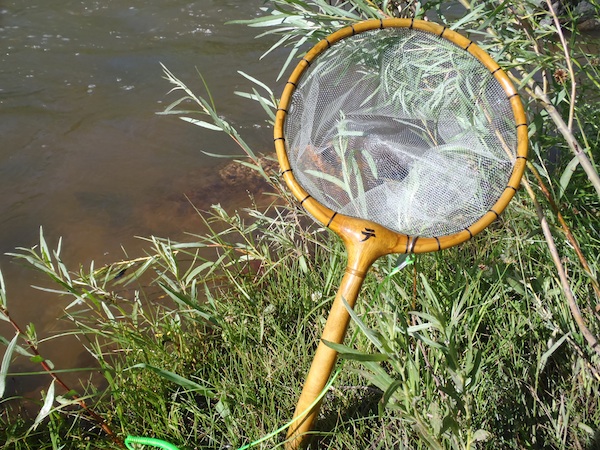
After many years of going “netless” I have recently become a strong advocate for using nets. I used to use a net when I fished for larger browns and rainbows back east. But for the small fish I was mostly catching since I moved to the Rockies, I always thought a net wasn’t really necessary and was just one more piece of gear to add to the “clutter” of all the other western gear I was bringing along.
But now that I’ve been using a net again, I’ve rediscovered it’s many advantages for both fish and fisher.
Advantages of using a landing net
- Provided you have fish-friendly mesh (i.e. fine enough not to snag fins or gills), a net is much gentler on the fish than hand landing. In the safety of the net, the fish is much less likely to injure itself by thrashing around on the rocks.
- The net allows you to keep the fish in the water, giving them the vital oxygen they need after the struggle. Imagine running a race, then immediately plunging your head in a bucket of water for 45 seconds when your still trying to catch your breath! That’s the way the fish feels when you take them out of the water to remove the hook.
- Keeping the fish in the net (and in the water) while removing the hook with hemostats means less contact with the fish’s skin which can remove their protective slime and invite diseases after being released.
- The net is an excellent picture taking tool. Since you can keep the fish in the water, you don’t have to rush to get your camera out and will have more time to get the perfect shot. The fish isn’t going anywhere and can breath so that gives you enough time to get a great photo.
- Nets that have a fine enough mesh can double as an insect net. Simply hold your net on the stream bottom for a few minutes to catch all kinds on nymphs and larvae that will give you better insight into what the fish might be feeding on. Another technique is to position the net just downstream of a rock, lift the rock up, and catch any insects that might be dislodged. I’ve even caught flying adult mayflies and caddis mid-air to identify them–like a miniature butterfly net.
- Nets improve your landing rate. A high percentage of break offs occur just as your bringing the fish to your hand. A net takes all the stress off the tippet sooner and reduces the chance of the fish breaking off.
Types of nets for Tenkara
Many years before I ever even heard of Tenkara, I carried an Orvis Stretch & Release net. It was a great net but because it’s long and shallow, it’s more difficult to keep the fish in the water because you have to almost keep the handle right on the water’s surface. And there was always the risk of the fish jumping out.
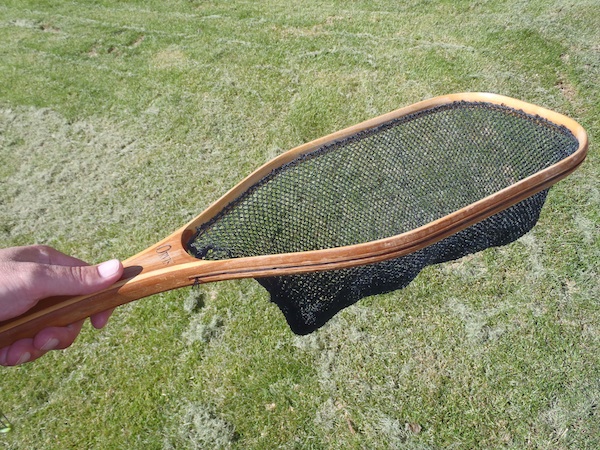
Orvis Stretch and Release Net
While it’s probably fair to say that any net will “work” with Tenkara, there is a certain style to the nets traditionally used in Japan. They tend to have round hoops, not rectangular like the net above. They’re usually deeper which makes it easier to keep the fish in the water and prevent them from jumping out of the net.
They also tend to have angled handles that allow you to tuck the net in your wader belt and carry it against your back. This keeps the net out of the way while still providing easy access. Here are a some examples of Tenkara style nets.
Tenkara USA Net
This is a gorgeous wooden net that is modeled after the traditional style of Tenkara nets, or, tamo. Traditional tamo are made from a single Y-shaped branch that is trained into shape through a fairly involved process. This particular net is actually made of two pieces of wood but still has a look and feel of heirloom quality. It would be difficult for most people to tell it’s a production model.
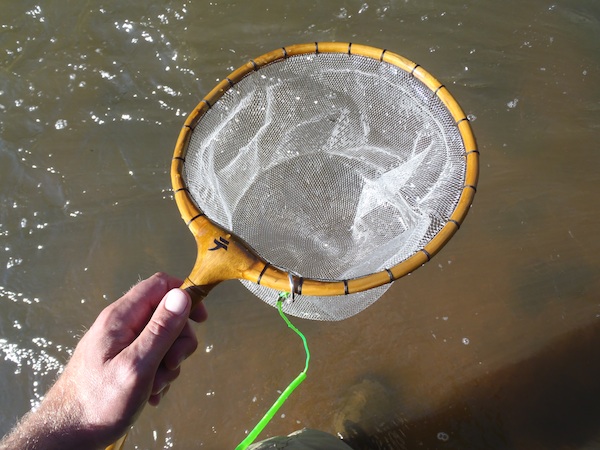
Tenkara USA Net
The mesh is a fine 2mm that will do double duty as an insect net as mentioned above. If you carry any Tenkara net, a good investment is a net leash. This allows you to attach one end to the net and the other to a belt loop or other piece of clothing to give you an insurance policy against loss on the stream:
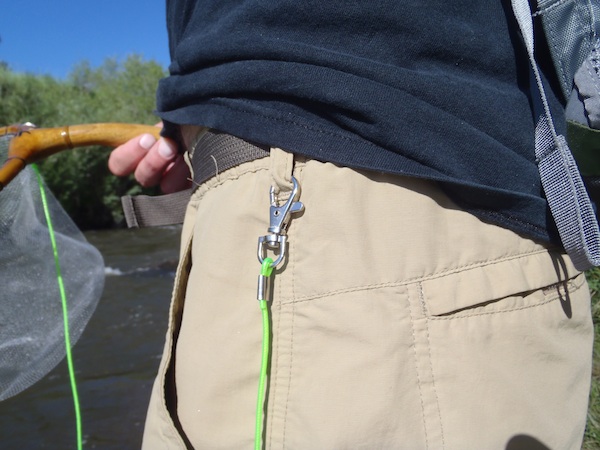
Tenkara USA Net Leash
I like this net a lot because the handle is very ergonomic and the hoop size if just right for the size of trout I typically catch. I also like the fact that the mesh is a light color which allows me to better see nymphs or larvae I catch while using it as an insect net. For the quality, the price tag is hard to beat. Get more information at Tenkara USA.
TrailLite Designs Ti Tenkara Net
Tenkara has become very popular with ultralight backpackers and for good reason. The rods are about as light and compact as you can get, making them ideal for packing into the backcountry. To meet the demands of the gram counting backpacker, TrailLite Designs has created a Tenkara-style net that gives you all the convenience and function in a mere 2.5 oz. net.
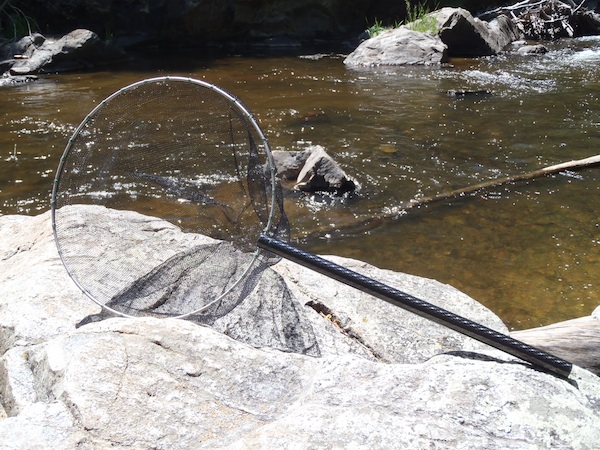
TrailLite Designs Ti Tenkara Net
The hoop is titanium while the handle is carbon for an incredibly light, yet incredibly strong net. It comes in two versions–one with an angled handle more like traditional Tenkara nets, and the other, straight to make it more compact for packing in a backpack.
I’ve always given up the convenience of nets while fly fishing on backpacking trips, but with this net, there’s no reason to. The mesh is the same 2mm mesh used on the Tenkara USA nets giving backpackers the multi-use feature of doubling as an insect net. For more information, visit TrailLite Designs. You can also read my review of the TrailLite Designs Ti Tenkara Net here.
DIY Tenkara Nets
If you’re slightly ambitions and a bit of a tinkerer, you can make your own Tenkara net. You don’t have to be an expert woodworker, but there is a bit of luck involved in finding just the right Y-shaped branch (in just the right type of wood) to start your project.
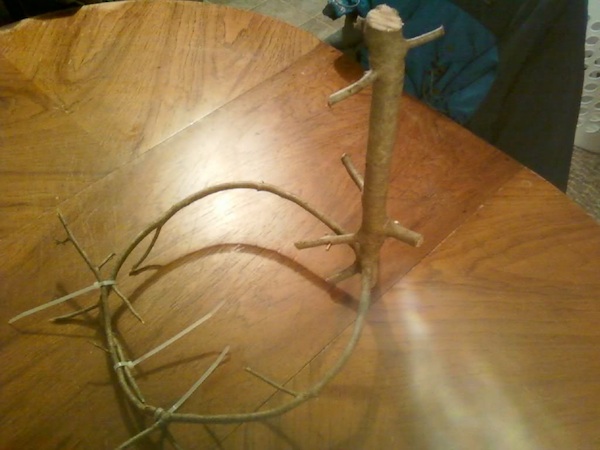
A DIY Tenkara net in progress by Dennis McGraw
A small, subculture has sprung up around DIY Tenkara net making. Perhaps it’s the lack of options available in the U.S. right now, or just the fact that it’s fun and rewarding to fish with a unique net you made yourself, but it seems to have already become a passion among many Tenkara Anglers.
The best resource right now for aspiring net builders is the Tenkara USA Net Forum. There, you will find many tips and advice for building your own nets as well as lots of examples of all the beautiful variations different types of wood and techniques can produce. It is truly a form of art.
Do you use a net for Tenkara? Which kind?





I never made the leap into using a tenkara-specific net…although the options are beautiful to behold.
I use a small Measure Net (from the website of the same name). Has been a perfect companion for the last year and a half of tenkara fishing.
Glad you enjoy your T-USA Tamo, I have found it very use and helpful landing fish and taking pictures of fish without taking them out of water. Is that a T-USA net leash? The one I got from T-USA looks different.
-K
Karel,
Yes, it is a T-USA leash. What looks different about it?
Hi Jason,
I live in Boston, MA and do most of my Tenkara fishing in the mountain streams of Massachusetts and New Hampshire. Going backpacking this weekend, and would like to pick out a good branch to make a net over the winter for next Spring’s season. (One more thing to keep me from going stir crazy in the city while the fishing is slack)
I’ve never seen Jeffrey pine grow in New England, and was wondering if there are any types of tree particularly well suited to net building in the East. Any help you can give me is much appreciated.
Tight lines,
Vic
Wish I could be of more help but I’ve never actually made my own net. It’s
something I’ve always wanted to do but just never got around to. You’d
probably get better advice from Daniel over at Tenkara USA. He’s got a lot of experience building nets.